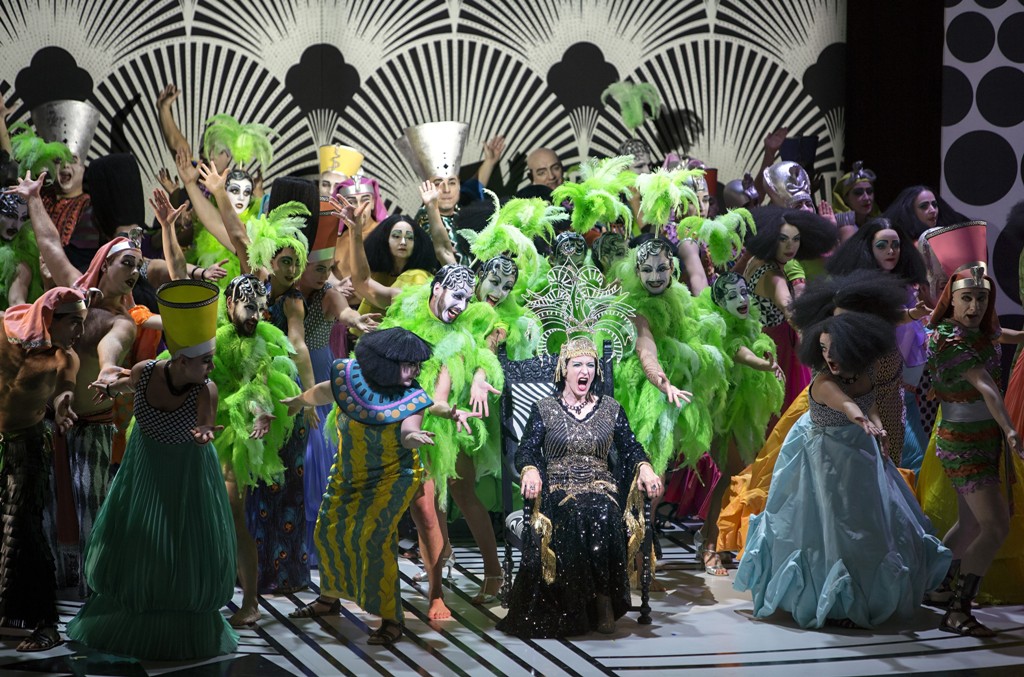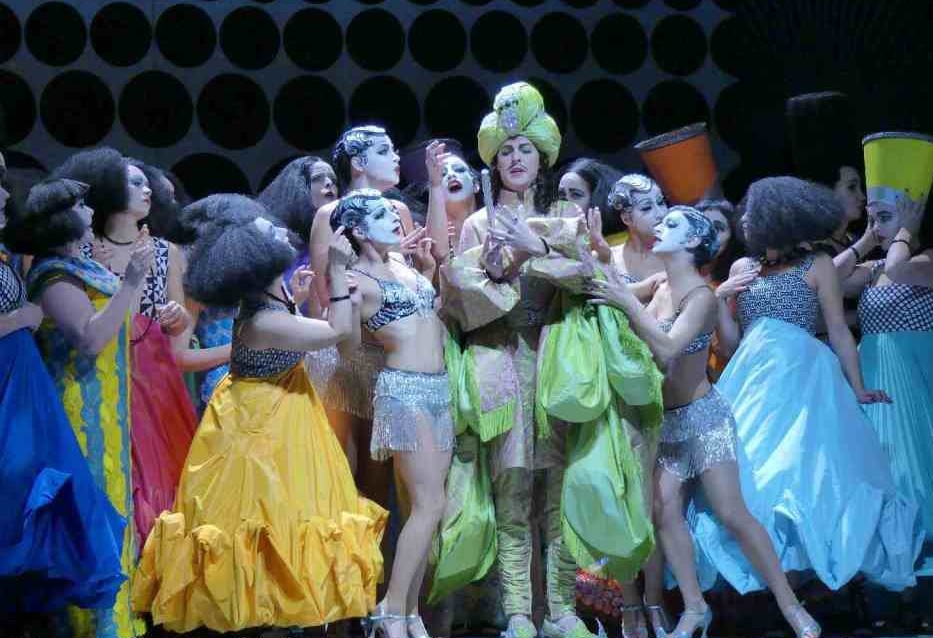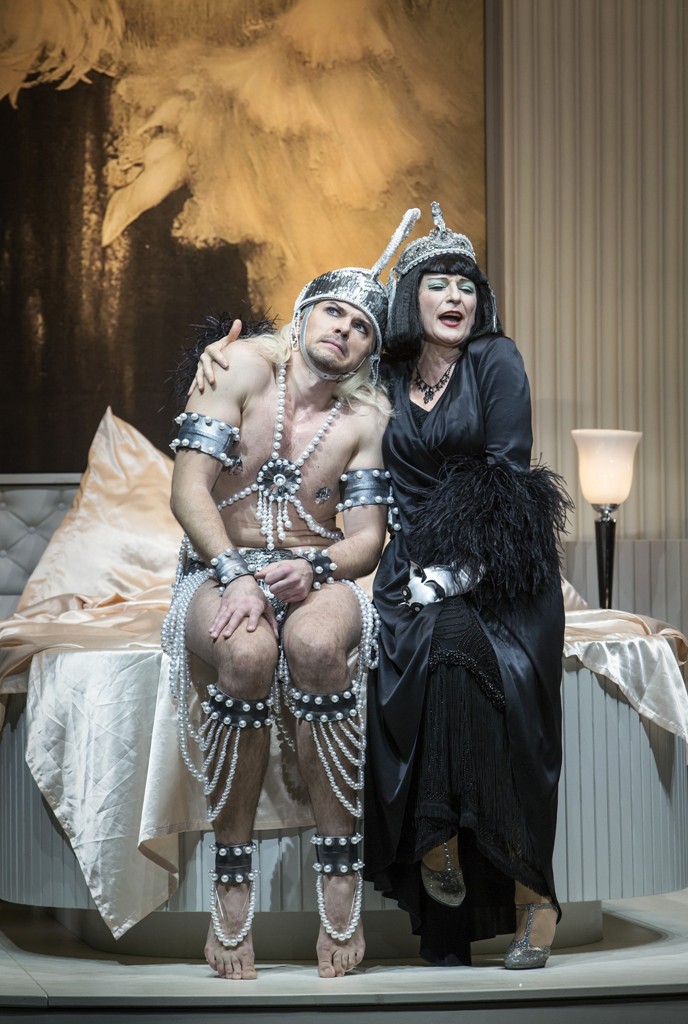Kevin Clarke
Operetta Research Center
10 December, 2016
It has arrived: the 2016 pull-out-all-the-stops operetta spectacle at the Komische Oper Berlin. The title of choice is Oscar Straus’ 1923 Viennese Die Perlen der Cleopatra, written for the one-and-only Fritzi Massary who brought it to Berlin a year later and landed a double-success as the Queen of the Nile, working her way through an army of men with the help of her famous “pearls” that dissolve in wine and work as aphrodisiacs. The result is a liberated “Egyptian” sex farce typical for the 1920s, showing a self-determined woman in power, using men for her political maneuvers and basically turning the old patriarchic system upside down.

Cover for the vocal score of “Die Perlen der Cleopatra,” by Oscar Straus.
Most American operetta fans will know Perlen der Cleopatra because Miss Massary, in her full gold Cleopatra costume, was immortalized in the New York subway with a mosaic at Lincoln Center station. It is a sight to behold and gives a vague idea of the magic effect Massary made a century ago.

Fritzi Massary as Cleopatra, at Lincoln Center subway station in New York. (Photo: Archive Operetta Research Center)
Because the show is comparatively early in the recording history of the genre, there are no well-known sound versions of the hit songs, in contrast to Straus’ 1932 Eine Frau, die weiß was sie will which was presented by the Komische Oper before this, in a congenial production with the same winning team: singing superstar Dagmar Manzel, conductor Adam Benzwi, and stage director Barrie Kosky. If Eine Frau was an intimate – even minimal – bravura production for two bravura actors in 30+ roles, this latest Straus offering is “Showtime in Egypt,” as someone screams into the auditorium at the very beginning, followed by pink confetti raining down on the audience. And that’s just the opening!

Dagmar Manzel as Cleopatra, surrounded by the chorus and dancers of the Komische Oper Berlin, in “Die Perlen der Cleopatra.” (Photo: Iko Freese/drama-berlin.de)
Mr. Kosky, with the help of his choreographer Otto Pichler, costume designer Victoria Behr and set designer Rufus Didwiszus, actually manages to visually top this grand opening again and again and reach a finale ultimo that is the exact opposite of what you might expect, i.e. an introspective moment of Cleopatra seducing Marc Anthony (Peter Renz) in her own “existentialist” way.
The music, with lyrics by Julius Brammer and Alfred Grünwald (who wrote Gräfin Mariza a year later), gets a royal update by Adam Benzwi. Not only did he work with all (!) soloists on the text extensively, making them deliver every nuance with that classic operetta double entendre so often missing in operetta performances with opera singers; Benzwi also re-arranged parts of the music, adding quotes from Verdi’s Aida and other Egyptian favourites here and there. He really gives these Perlen a new sound-life that goes far beyond the typical operetta re-writes or so called “adaptations” we have (sadly) become accustomed to in post-WW2 decades. This is an intelligent and witty update that keeps the 1920s style, but makes it accessible for modern ears: as a Roaring Twenties show.

The headlines for “Perlen der Cleopatra” in 2016. (Photo: Komische Oper Berlin)
Most German critics were enthralled by Miss Manzel and her stunningly versatile acting abilities, rightly so; yet they unanimously claimed the show itself lacked substance, in terms of plot. Music critics wrote the story was nonexistent and had no relevance for today. This is slightly astonishing: because a “dictator” in an Arab country, ruling with an iron fist and highly irrationally, sentencing people to death one minute, then using the religious faith of the people to subdue them with unholy bogus, seducing army officers for private entertainment etc. etc. is as topical as can be, you’d think. Add to this the political intrigues at the Egyptian court, arranged by shady minister Pampylos (Dominique Horwitz). And add the way all of this is twisted around by placing a female ruler at the top, in a men’s world. You’d think there could hardly be more topicality from today’s perspective.
But Barrie Kosky has chosen to not highlight any of the obvious paralleles with current political events in the Middle East.
His high camp approach is never disturbed by any reference to events, situations and people we see in the news daily. On the one hand this makes these Perlen der Cleopatra timeless, but it also forces viewers to find their own interpretation. (Obviously something German opera critics are not used to.) It also takes away some of the darker, more disturbing aspects of the show, mostly when it comes to Pampylos who would have given the operetta more depth and danger in a different portrayal: here, he is nothing more (and nothing less) than a crazed drag queen. This is not without many fun elements, but it’s also very one dimensional.

Johannes Dunz presenting his “Little Flute” at the Egyptian court of Cleopatra. (Photo: Frank Wesner/alleseintheater.wordpress.com)
The all-round casting is superlative and surprising. The biggest surprise is Johannes Dunz as Prince Beladonis singing about his “Little Flute” with Fritz-Wunderlich-like tenor tones that are simply: wonderful. Especially, because Dunz manages to color them with so many suttle shadings that is a joy to hear, and his improvised coloratura cadenza at the end of the “Kleine Liebesflöte” song, with floating pianissimo top notes, brings down the house. Next to him, the other young singer of note is Talya Lieberman as Charmian, Cleopatra’s maid. Miss Lieberman sings ravishingly with a clear soprano, she blows the Egyptian trumpets in a way that would qualify her for any upcoming Gypsy revival, and she can dance, too. This she does, in a kind of Ginger and Fred moment, with Dominik Köninger as Silvius. The role was originally written for Richard Tauber who seduced both Charmian and Cleopatra with his tenor, here the music is re-arranged for a high baritone. This works well and contrasts young Beladonis with the slightly more mature Silvius.

Dominik Köninger as Silvius, being bedded by Dagmar Manzel in “Die Perlen der Cleopatra” at the Komische Oper Berlin. (Photo: Iko Freese/drama-berlin.de)
Peter Renz as Marc Anthony – a role successfully played by Hans Albers in Berlin in 1924 – is anti-casting, but Renz manages to pull it off, turning the final scene with Miss Manzel into something unexpected: two old and world-weary people meeting in a sarcophargus, beer bottles in hand, refelecting on the passage of time. It’s a kind of Beckett moment you would not forsee, and it’s glorious. Especially because the duet Cleopatra and Marc Anthony share, “Ach Anton steck’ den Degen ein,” is the crowning glory of this evening.
If you only know Perlen der Cleopatra via the uninspired cpo recording from Bad Ischl 2003, with Morenike Fadayomi in the title role, you will appreciate all the more what Manzel and Benzwi have done here with this duet, and the many other musical glories of the score. It’s a true sonic rediscovery of Oscar Straus that sets new standards in operetta singing, because every syllable Miss Manzel touches is turned into gold. It’s an amazing act to watch and hear. (And just for the record: there was an earlier revival attempt, in 1998, by Peter P. Pachl and his pianopianissimo musiktheater. This production had a counter tenor in the title role, cross dressed, and it toured Germany, there is even a YouTube clip of the “Flute of Love” song which makes it immediately clear why the Pachl staging of Perlen der Cleopatra never stirred as much general interest as the new übertrendy Barrie Kosky/Adam Benzwi version.)

The 2003 recording of “Perlen der Cleopatra” from Ischl. (Photo: cpo)
By bringing all of these people to operetta and by establishing a new look, sound and acting style for the genre, Barrie Kosky has done something remarkable: he has made operetta an attractive big city phenomenon again. By refusing to just stick to the established hits, he has also opened our eyes, ears and minds for the enormous richness of operetta repertoire, and its incredible diversity.

Dagmar Manzel as a very 1920s Queen of the Nile in “Perlen der Cleopatra” at the Komische Oper Berlin. (Photo: Iko Freese/drama-berlin.de)
For that, Mr. Kosky and his Komische Oper team would deserve a Bundesverdienstkreuz. (If you ask me.) He certainly deserves the sold-out performances that prove: audiences are ready for a new approach to operetta, an approach that differs from what you get in Ischl, Wooster, even in Vienna. And that’s reassuring.
You can watch a live stream of Berlin’s new Perlen der Cleopatra online until Christmas, with English subtitles; click here for that. Let yourself be transported by Dagmar Manzel and her white cat Ingeborg, by these dancers, and by a wonderful Oscar Straus operetta that fully deserves this 2016 revival.
“Welcome to Ancient Egypt, Berlin style!” Thank you, Barrie & Co.!
All images by Iko Freese are from www.drama-berlin.de (Agentur für Theaterfotos).

I cannot imagine Tauber as Silvius!!! Or rather, I can – and I don’t want to!!! And the Livestream was/is superb, especially the sound. I’m so glad I have booked to see it twice!!
Fantastic! When will someone bring Kosky, Benwi, and Menzel to the US?
There was a period of about 5 to 6 years during which neither Massary nor Pallenberg made any recordings. It began around 1921 and lasted until the Pompadour revival. I’ve never found an explanation for this but suspect it had to do with royalty payments.